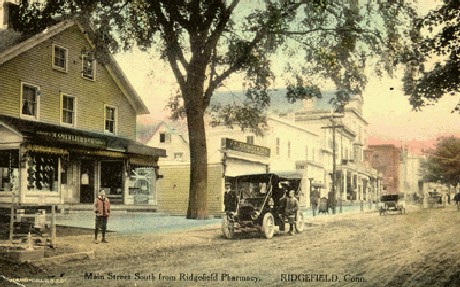|
Altnacraig
a spectacular High Ridge mansion that burned down.
The Bailey Inn
well-known tourist stop in first quarter of the 20th
Century.
The Bissell Building
a view from the 1950s of the building that burned down in
2003..
Branchville
looking across the Norwalk River.
Branchville
Station
Two very early views.
Branchville Silex Mills
once Ridgefield's biggest factory.
Cannonball House
now the Keeler Tavern Museum, in a wonderfully colored view.
Cass Gilbert
Fountain, designed and donated by a leading American architect
who lived in the Cannonball House (above).
East Ridge
sweeping view east of Main Street.
The Elms Inn
then called Elm Shade Cottages.
Firehouse
on Catoonah Street, shortly after it was built in
1908, with fire bell tower.
First National
Bank
at Main and Governor Streets, showing a couple of
chauffeurs chatting with a man in a straw hat.
Graeloe
the estate that's today Ballard Park and was once the home of
a Revolutionary hero.
Governor
Street
with East Ridge in background, showing a family about 1908.
Grovelawn
home of Gov. Phineas Lounsbury, is now the Community
Center.
Hermit
of Ridgefield
showing George Washington Gilbert and the saltbox that
crumbled around him.
Holy
Ghost Novitiate
later acquired by the town, now housing for elderly.
Lynch
Estate
high up on West Mountain, and a view therefrom.
Main
Street
looking south from Ridgefield Pharmacy around 1910.
Main
Street
looking north from south end, with two side-saddled women
ca. 1908 view.
Main
Street
looking north from opposite Rockwell Road, showing homes
and lawns and a glimpse of the Corner Store.
Main
Street
including Walker's Happy Shop and S.S. Denton building,
late 1920s.
Methodist Church
a beautiful building that stood in the heart of the
village and was, alas, razed in the name of "progress."
Northern
Main Street
showing the large old maples around 1907.
Outpost
Farm
The home of Col. Louis D. Conley was the center of what's now the
'Bennett's Pond' property.
Outpost
Inn
on the site of Fox Hill condos, was built for a bride,
and was torn down by a man who went to prison.
Port of
Missing Men
on Titicus Mountain, once a resort for wealthy sportsmen and now the
Eight Lakes neighborhood..
Railroad
station
on Prospect Street, now part of Ridgefield Supply.
Ridgefield
Inn
in its heyday around 1910. It also served as Ridgefield
School for Boys (below).
Ridgefield
School
for
Boys (and Ridgefield Inn)
south end of Main Street
Ridgefield
School
on a 115-acre campus off North Salem Road (1911-38).
St.
Mary's Church, Rectory
around 1910.
The Scott
Block
where the post office was in the 1920s.
St.
Stephen's complex
showing the old church later razed, and the rectory,
later moved.
Smith
Tavern
a 19th Century watering hole on the site of the present
library.
Stebbins
House
a hospital during the Battle of Ridgefield in 1777.
Sunset
Hall
the estate once eyed as headquarters of the United Nations.
Town
Hall
around 1905, showing women in Victorian garb, a horse and
carriage, and the old firehouse.
Upagenstit
West Lane estate of Frederic E. Lewis, later home of an international
revolutionary and bridge player, then a college for women, finally
alleged Communist hangout.
West Lane
looking eastward from around Parley Lane.
West Lane
looking westward from around Parley Lane.
West
Lane
Schoolhouse
where Peter Parley got his early education.
The
Wiggins place
home of the man who made Chase the richest bank in the world.
Windover
West Lane estate of Life Magazine founder and novelist John
Ames Mitchell.
|
|
on
RidgefieldHistory.com

Main Street looking south
toward town hall (in distance) about 1915
Here
are early 20th Century postcard views of Ridgefield, Connecticut, from
a collection that includes more than 600 postcard pictures of the town
in the first half of the century.
Because Ridgefield was considered a "resort
town" early in the 20th Century, many postcards views of Main Street,
village homes and mansions, churches, inns, landmarks, and scenic
landscapes were published between 1900 and 1940.
Before World War I, many of the cards were
printed in Germany on the finest color presses then available. The war
forced American postcard publishers to turn to an old-fashioned method,
and many views from 1916 to 1940 were literally hand-colored.
Most of the cards here were commissioned and
sold by either H.P. Bissell's Drug Store, still in operation today more
than a century after it was founded, or by George A. Mignerey, operator
of the other pharmacy on Main Street, or H.D. Smith, another pharmacist.
Jack Sanders, who compiled these pages, is
always interested in acquiring old Ridgefield postcards. He can also
produce scans, or enlarged, full-color copies, suitable for framing, of
more than 600 different cards, only a few of which are shown here. He
is also available to do a digital slide show on big screens, showing
more than 100 old postcard views of Ridgefield. (Digital projector must
be provided!) For more information, please e-mail him at jackfsanders[at]yahoo.com.
More images are
posted periodically.
Last updated Sept. 3, 2010.

Entire contents
copyright © 2010 by Jack Sanders. Text or images may not be reproduced
without the permission of the author.
|



